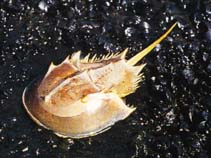Limulus polyphemus (Linnaeus, 1758)
Horseshoe crab| Native range | All suitable habitat | Point map | Year 2050 |

|
| This map was computer-generated and has not yet been reviewed. |
| Limulus polyphemus AquaMaps Data sources: GBIF OBIS |
Classification / Names Common names | Synonyms | CoL | ITIS | WoRMS
Merostomata | Xiphosura | Limulidae
Environment: milieu / climate zone / depth range / distribution range Ecology
Benthic; depth range 3 - 11 m (Ref. 76). Tropical, preferred 24°C (Ref. 107945)
Distribution Countries | FAO areas | Ecosystems | Occurrences | Introductions
Western Atlantic: from Maine, USA to Mexico.
Length at first maturity / Size / Weight / Age
Maturity: Lm ? range ? - ? cm Max length : 60.0 cm TL male/unsexed; (Ref. 82); max. published weight: 1.8 kg (Ref. 82); max. reported age: 20 years (Ref. 99652)
Life cycle and mating behavior Maturity | Reproduction | Spawning | Eggs | Fecundity | Larvae
Main reference
References | Coordinator | Collaborators
Lee, C.N. and B. Morton 2005 Experimentally derived estimates of growth by juvenile Tachypleus tridentatus and Carcinoscorpius rotundicauda (Xiphosura) from nursery beaches in Hongkong. Journal of Experimental Marine Biology and Ecology 318:39-49. (Ref. 1131)
IUCN Red List Status
(Ref. 130435: Version 2025-1)
CITES status (Ref. 108899)
CMS (Ref. 116361)
Threat to humans
Human uses
Fisheries: commercial
FAO - Fisheries: landings | FIRMS (Stock assessments) | FishSource | Sea Around Us
Tools
More information
Max. ages / sizes
Length-weight rel.
Length-length rel.
Length-frequencies
Mass conversion
Abundance
Internet sources
BHL | BOLD Systems | CISTI | DiscoverLife | FAO(Fisheries: ; publication : search) | Fishipedia | GenBank (genome, nucleotide) | GloBI | Gomexsi | Google Books | Google Scholar | Google | PubMed | Tree of Life | Wikipedia (Go, Search) | Zoological Record



